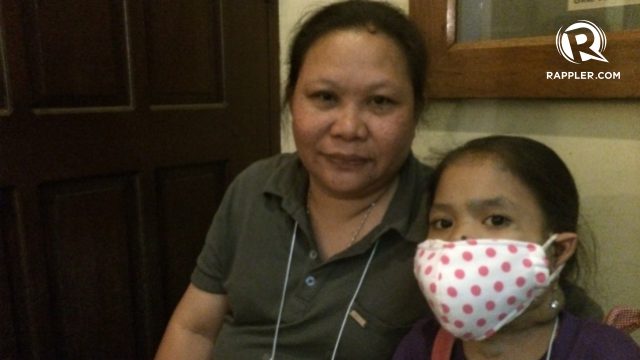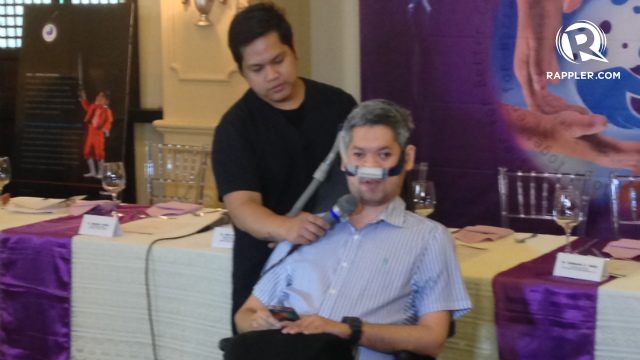SUMMARY
This is AI generated summarization, which may have errors. For context, always refer to the full article.

MANILA, Philippines – For the last 15 years, Ziv Morejon depended on blood transfusion to live.
When she was born in a hospital in Iloilo, doctors thought she had hemangioma – a usually benign tumor made up of blood vessels – due to lumps in her head and tongue.
When she reached 3 years old, the doctors at the Philippine Children’s Medical Center (PCMC) still thought it was hemangioma. She went under chemotherapy and medication for 9 months but both did not help and even aggravated her condition.
Her parents decided to stop the treatment. They went back to blood transfusion, wondering whether Ziv will spend the rest of her life like this: one blood unit a day, 5 times a week, to keep her hemoglobin from dropping.
“‘Yung treatment niya, salin lang ng dugo kasi bumabagsak ‘yung hemoglobin n’ya dahil sa internal bleeding dahil affected na intestines niya,” said her mother, Fe. (Her treatment is blood transfusion because her hemoglobin drops because of internal bleeding and her intestines are already affected.)
It was only when Ziv was 9 years old that they learned she was suffering from Blue Rubber Bleb Nevus Syndrome. It is described by an American Academy of Pediatrics study as a rare disease characterized by discrete venous malformations of varying size and appearance on the skin, within the gastrointestinal tract, and, less often, in other organ systems.
PDAF, other sponsors
Fe, depended on the government for her daughter to live. Her husband’s income as a company driver might be enough for a family of 5, but they couldn’t afford Ziv’s medical expenses.
It had been a way of life for Fe since coming to Manila: she would line up, like thousand of others, to ask help from legislators back when the pork barrel was still constitutional.
Two years ago, Fe learned about the Philippine Society for Orphan Disorders (PSOD) through Ziv’s doctor at PCMC. Including Ziv, there used to be only two cases of Blue Rubber Bleb Nevus Syndrome in the organization.
Now there’s only Ziv.
The World Health Organization defines a rare disease as an often-debilitating disease or condition with a prevalence of 0.65% to 1%.
In the Philippines, a disease is considered rare when it affects one patient in every 20,000 population, according to Dr Sylvia Estrada, a metabolic specialist.
Through sponsors, Ziv started taking a new medicine last April. Effects have so far been positive, with the teenager taking two units of blood per week instead of 5. This is a gleam of hope for Fe. For now.
The sponsorship will only last for 6 months, while the controversial Priority Development Assistance Fund is no more. A tablet of Ziv’s medicine – which she takes once a day – costs P480 every tablet. Her laboratory fees go as high as P5,500 every month.
For Fe and other parents whose children suffer from rare diseases, government support can be their lifeline.
Legislation needed
Their pleas have fortunately reached a number of legislators. Since 2013, these lawmakers have been filing bills both in the House of Representatives and the Senate concerning patients with rare diseases:
- Senator Miriam Defensor-Santiago and Representative Sol Aragones – bills that mandate research on rare pediatric diseases and conditions
- Senator Pia Cayetano, representatives Randolph Ting, Alfred Vargas, Rose Marie Arenas, and Gus Tambunting – bills that mandate a comprehensive policy to address needs of persons with rare diseases
- Representative Diosdado Macapagal-Arroyo -–a bill that creates a Department of Health Office of Rare Diseases, and provides incentives for manufacture or importation of healthcare products for persons with rare diseases
Different versions of the bill, which also seeks the creation of a rare disease registry in the country, will be consolidated into a measure that advocates hope will be enacted during the 16th Congress.
There are about 7,000 known rare diseases which are chronic, progressive, and usually causing serious health problems. Experts say many common types of rare diseases already have treatment, and early intervention makes a lot of difference.
Former Health Secretary Jaime Galvez-Tan said the greatest challenge of the health sector today will not be funding healthcare for patients with rare diseases but their inclusion as well as the inclusion of indigenous people, people with disabilities, and older persons in universal healthcare.
“Why? Because society does not give them the right importance that the law has already given them. We need a [republic act] to protect them,” he said.
Supporting patients with rare diseases is also in line with the United Nations Convention on the Rights of the Child and the country’s Millennium Development Goal 4, PSOD founding chairman Carmencita Padilla said.

Juan Magdaraog, a patient advocate with Pompe Disease, can attest that a decent quality of life is possible for children with rare diseases, especially with support from government and the private sector. (READ: ThisAbility: 10 life lessons Pompe Disease taught me)
“Rare diseases often need lifelong treatment and care. It’s not a cure you give today and it’s done – it’s for the rest of their lives. Proper infrastructure and policies should be put in place for equal chance for patients with rare diseases,” said Magdaraog, now a web developer who finished college from the De La Salle University-College of Saint Benilde.
Ziv wants to be a doctor. Perhaps because she has always been surrounded with plenty of them all her life, she wants to be a doctor someday. She fights on, hoping one day she becomes healthy enough to enter not just a hospital, but also a classroom. – Rappler.com
Add a comment
How does this make you feel?
There are no comments yet. Add your comment to start the conversation.